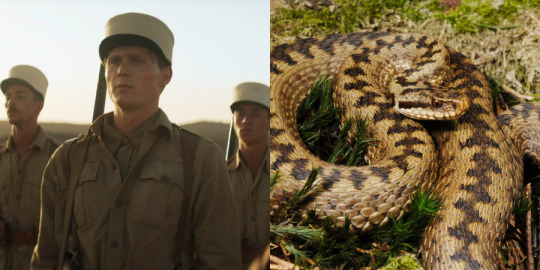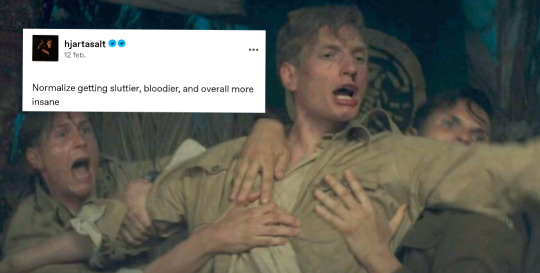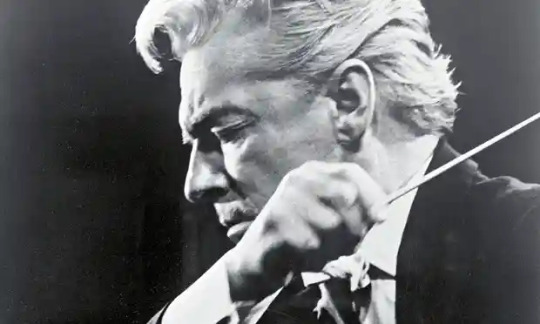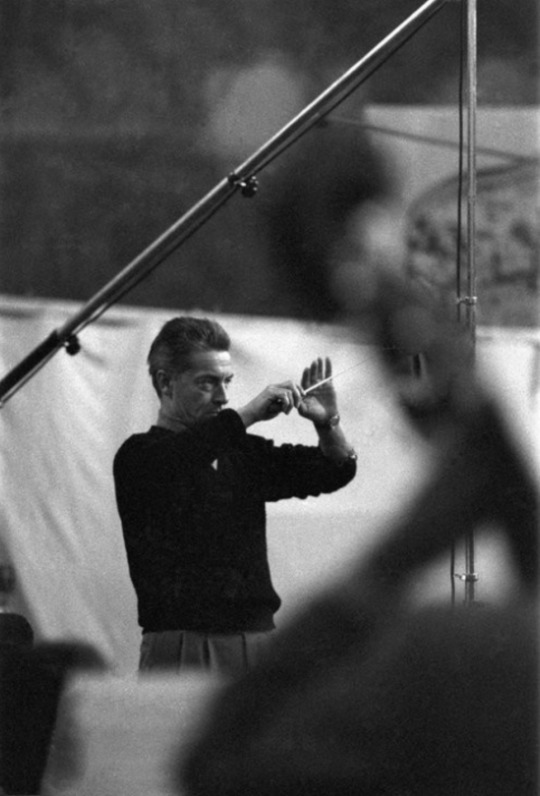#herbert bruckner
Text
SAS Rogue Heroes Daemons AU
Hello, I am here to once again encourage SAS: Rogue Heroes brain rot with yet another au (help I've fallen down the rabbit hole)
David Stirling - Cuckoo (adaptable, dreaming, foolishness, insanity, insecurity)

Paddy Mayne - Tiger (strength, power, aggressiveness, leadership, courage, intelligence, passion, stealth, solitary, bringer of death and destruction)

Eoin McGonigal - Spider (patience, creativity, sensitivity, protection, wisdom)

(I can't stand spiders I'm afraid - arachnophobic - so no picture here, sorry)
Jock Lewes - Beaver (determined, visionary, defensive, inventor, fantasizer)

Eve Mansour - Serval (independence, self-reliance, and self-interest for the sake of survival)

Mike Sadler - Armadillo Girdled Lizard (adaptability, instinct, quick-witted, sensitivity)

Reg Seeking - Honey badger (strength, fierceness, aggressive, endurance, survival, territorial, possessive)

Johnny Cooper - Otter (playful, mischievous, kindness, happiness, luck, loyalty, and adaptability) (thanks to @just-barrow for this)

Bill Fraser - Spotted hyena (loyal, courageous, social but also solitary, witty, smart, hunters rather than scavengers, territorial)

Dave Kershaw - Ring-tailed Lemur (playful, kindness, happiness, social, leisure, alert) (credit to @rosescruensixxam for saying that Dave's lemur would be like King Julian - a sassy mf)

Pat Riley - Red squirrel (playful, mischievous, social, passionate, trust, hardworking, resourcefulness)

Jim Almonds - Hare (courage, prosperity, rebirth, change, vigour, aggressiveness, cleverness, love, sensitivity)

Augustin Jordan - Great horned owl (wisdom, strength, fearless, decisive, freedom, stealth, protection) (thanks to @rosescruensixxam for helping me decide)

André Zirnheld - Peregrine Falcon (fearless, authoritative, goal-oriented, freedom, intelligence, victory, power, speed) (thanks to @rosescruensixxam for helping me decide)

George Bergé - Lioness (Pride, courage, power, natural-born leaders, authority, dignity, wisdom, fiery)

Dudley Wrangel Clarke - Chameleon (adaptability, change, deception, intuition, transformation)

Dr Gamal - Hummingbird (flexibility, healing, ability, unique, joy, enjoyment of life)

Walter Essner - Doberman pinscher (alert, fearless, loyal, aggressive, impulsive, social, self-protection, misunderstood) (thanks to @wearebackbagels for helping with Essner)

Herbert Bruckner - Common European Viper (impulsive, power, shrewdness, rebirth, deception, mistrust, temptation, death and evil) (credit to @wearebackbagels for this brilliant suggestion)

General Auchinleck has a golden monkey daemon (like Marisa Coulter), and General Ritchie has a horse (don't ask me what kind, I don't know horses)
And that's about as far as I've gotten, so please, come yell ideas at me in the comments bc I'm sorta stuck for everyone else
@rosescruensixxam @wearebackbagels @elkro @just-barrow @onyxsboxes @adowbaldwin @invisiblegargoyl @bachaboska @kuro-anko @snitling @fergusfraserapologist @akatsuki-rin @queerevolutionaries @cloudyfacewithjam
#sas rogue heroes#daemons#daemons au#his dark materials au#paddy mayne#david stirling#eoin mcgonigal#jock lewes#dave kershaw#augustin jordan#mike sadler#johnny cooper#reggie seekings#andré zirnheld#georges bergé#walter essner#herbert bruckner#jim almonds#bill fraser#pat riley#eve mansour#sas: rogue heroes#sasrh#sasrh au#sas rogue heroes au#au#100#200
224 notes
·
View notes
Text
SAS Rogue heroes: X-Men au
For a while now @rosescruensixxam and I have been working on an X-Men au and here are part 1 out of 3 planned posts, the rest will come soon enough.
This is everyone’s powers, we TRIED to do the characters justice but at least we had fun while doing it!
DAVID STIRLING: Power bestowal and augmentation, disintegration

PADDY MAYNE: Metal claw growth, Superhuman Durability, Adaptive Reflexes, Superhuman Marksmanship, Impenetrable Skin, life force absorption (alias Mad Dog)

JOCK LEWES: Energy Manipulation, Energy Blasts, Molecular Acceleration, Superhuman Durability, (alias Oppenheimer?)

JOHNNY COOPER: Slowed down aging, superhuman reflexes, super leaping, superhuman speed, wall crawling, superhuman agility( he is basically Nightcrawler) (alias Sparrow( from “The Sparrow from Minsk”) nobody is gonna get this)

AUGUSTIN JORDAN: Life Force Absorption and conduction, blood bending, Adaptive Evolution/ Immortality, Superhuman Marksmanship, (alias Vampire/Twilight haha)

MIKE SADLER: Wolf transformation, shapeshifting, Superhuman Durability, super acute senses, razor sharp teeth (alias Coyote idk)

REGGIE SEEKINGS: Mutant tattoos includes (making tattoos come to life) tactile hypnosis, superhuman durability ( more will be added)

EVE MANSOUR: Chronoskimming, mind reading, some ice-powers cause she is cool all the time

BILL FRASER: Pyrokinesis, solar form, solar absorption, flight, wing growth/wing blades (alias Icarus( coolest name ever)

DAVID KERSHAW: Animal manipulation, animal empathy (alias Kitten?)

EOIN MCGONIGAL: Weather Control( ironic we know), lightning travel, cyclone spinning, aerokinesis, flight

GEORGES BERGÈ: Hydrokinesis (alias Wave, Riptide, Crescent( like the moon)?)

ARNDRÈ ZIRNHELD: Illusion generation, mind/physical control (alias Vision?)

PAT RILEY: X-Factor Detection, Telepathy, Force Field Generation (alias Shield?)

JIM ALMONDS: Healing factor, (alias Nurse?)

MARC HALÈVY: Self detonation, shockwaves (alias Grenade? pull the pin and throw me where the enemy is most numerous)

HERBERT BRUCKNER: Invisibility, shapeshifting, self duplication

WALTER ESSNER: Electrokinesis, technopathy( if frying phone batteries count), lightning travel?( eventually)

(alias Surge? something like that, I can imagine someone at the school calling Walter “Sparky” in a joking way not knowing about his past( part of a fic we wrote) and the guy just tranformes into that ptsd war dog meme)

I AM SO SORRY HAHAHA
THAT MEME MADE ME CHOKE ON MY FOOD LMAO, that is what im here to do, kinda
@elkro @just-barrow @onyxsboxes @adowbaldwin @invisiblegargoyl @booksoncanvas @bachaboska @kuro-anko @snitling @fergusfraserapologist @akatsuki-rin @rosescruensixxam @queerevolutionaries @cloudyfacewithjam I think that was everyone, get over here guys!
#sas rogue heroes#x-men#I will post a draft with all explanations now#hold up#paddy mayne#david stirling#dave kershaw#augustin jordan#jock lewes#Mike Sadler#johnny cooper#reggie seekings#andré zirnheld#georges bergé#walter essner#herbert bruckner#jim almonds#bill fraser#pat riley#eoin mcgonigal#eve mansour#sas: rogue heroes
112 notes
·
View notes
Text


....fuck 🙈🙈🙈🙈🙈 I can't with this man
@wearebackbagels. @rosescruensixxam
96 notes
·
View notes
Text

SAS: shitposts 142/∞
41 notes
·
View notes
Text
Karajan: a new film – and the controversy continues
Tom Service
The Guardian
London, UK
Thu 4 Dec 2014 @ 03:00 EST
The conductor – who led the Berlin Philharmonic from 1956 to 1989 – is the subject of a new BBC documentary. But he remains an enigmatic figure, whose musical approach sounds a false note in today’s world.

📸 Visionary? Conductor Herbert von Karajan in 1976. Photograph: Bettmann/Corbis
Herbert von Karajan. He’s both an icon and an enigma in the story of 20th century music. Baton aloft, hair expertly coiffed, shot in soft-focus lighting from the left (he insisted he was photographed from what he thought was his best side), he is the familiar face of millions of records, videos, laserdiscs, and now DVDs and downloads, the person who arguably did more to turn symphonic music into a commodity in the postwar era. He is also the despotic maestro of imperialistic ambition, who wanted to conquer every available media possibility and turn them into publicity-generating – and commercially lucrative – opportunities for him and his orchestra, the Berlin Philharmonic.
But Karajan the man remains elusive: a conductor who didn’t – and possibly couldn’t – form friendships with the musicians he led for more than 30 years, whose political past (he was a member of the Nazi party) was a dark halo over his reputation throughout his life, and whose music-making itself, for all its gigantic success, has now become a legacy that most of today’s conductors openly repudiate. Karajan’s approach, they say, represents an ideology in which the superficial gloss, finish and perfection of orchestral sonority is an end in itself, a one-size-fits all solution for repertoires from Bach to Berg, from Mozart to Mahler, which ironed out the expressive edges of everything he conducted. Simon Rattle, for one, has talked about how he was “slightly repelled” by the Karajan sound when he heard it in the flesh for the first time, and he’s just one conductor who feels that Karajan – “the emperor of legato” – belongs to a musical world that has no place in today’s orchestral culture.
It’s all of those myths, cliches, and phenomena that John Bridcut’s new film – Karajan’s Magic and Myth, broadcast on BBC4 on 5 December – interrogates, in the BBC’s first commissioned film on the conductor, 25 years after his death. There are some fascinating moments: interviews with musicians from the Philharmonia in London in the early 1950s, from the Berlin Phil, fellow conductors Nikolaus Harnoncourt (who played as a cellist for Karajan in the Vienna Symphony Orchestra) and Mark Elder, and a handful of the starry soloists he worked with in the later stages of his career, Placido Domingo, Anne-Sophie Mutter, and Jessye Norman.
Most illuminating of all are the glimpses you’re given of a man and musician who didn’t conform to the one-dimensional caricature he has become for some: far from a dead-eyed perfectionist, Karajan actually ignored obvious imperfections, such as a magnificently obdurate fluffed note from the fourth trumpet in one of his recordings of Strauss’s Alpine Symphony, in favour of the overall sweep of a longer take in the studio – or possibly because it was cheaper not to patch it up.
Karajan’s undoubted vanity comes over as one of the strongest indictments of his personality: not just the whole left-side-is-my-best-side thing, but making sure that his principal flute James Galway wasn’t visible in his films, because Karajan didn’t like Galway’s facial hair. Conversely, he didn’t like baldness either in himself or his orchestral players, and he made follicly challenged musicians wear wigs for the filmed sessions – even if they were often invisible since the camera focused for the vast majority of the time on Karajan and his closed-eye conducting, and on the instruments rather than the actual players.
But the biggest issue of all, the question of how Karajan actually produced the performances he did, remains unanswered in Bridcut’s film, as it does in the other Karajan documentaries that have been made. There are the crazy facts of his contract with the Berliners – that they were to be at his beck and call around the clock whenever he was in Berlin, summonable at a moment’s notice for a recording, rehearsal, or film session – but even accounting for Karajan’s famed magnetism and charisma on the podium, it’s hard to completely understand how he was able to command such complete authority over his musicians and orchestral culture all over the world.
It’s possible that Karajan is a phenomenon that today’s musical culture just couldn’t tolerate (although the fetishisation of the conductor figure continues unabated; just think of the adulation, marketing and hype around Gustavo Dudamel, for example), but the other side of it is the sheer scale of Karajan’s achievement. In rejecting Karajan’s recordings, we risk underestimating both the sheer intensity and indelible power of the sound world he created, and the sophistication of what he was doing musically. He also made visionary use of the latest media.
A few examples: watch his films with Henri-Georges Clouzot, rehearsing and performing Schumann’s Fourth Symphony and Beethoven’s Fifth. Karajan and Clouzot turn the art of orchestral rehearsal and music analysis into sensual filmic experiences. Of course, Karajan is performing for the cameras, but the substance of what he is saying when he tutors the hapless student conductor is rivetingly insightful, as is his forensic, multi-dimensional explosion of the start of Schumann 4.
These are suggestions (and there are others in the surprising amount of Karajan rehearsal footage on YouTube) of an essential approach to music-making, a way of building an orchestral score and a symphonic sound world from the bottom up, so that the symphony or opera or tone poem is generated from the basics – and the bass lines – of its harmonic momentum.
Karajan seemed to feel each piece he conducted as a single sweep of musical momentum made up of interconnecting lines of melody and harmony. His closed eyes, by the way, aren’t only about a mystical communion with an internal world of the music (and an incomprehensible mode of communication for Simon Rattle, and most other conductors), but a way of recalling the score, which, it’s said, he could see in his mind’s eye, turning the pages in his imagination. He had to keep them shut, otherwise he would lose his concentration.
But it’s his physical gestures that really tell this story of what he’s doing. So often, Karajan is reaching down with his hands, moulding and kneading a kind of sonic plasma that seems to begin somewhere beneath his podium, in the bowels of the earth – or at least with the Berlin Phil’s double bass players – and emerges upwards with volcanic force. That’s why his Bruckner, his Brahms, his Sibelius, his Wagner is so thrillingly powerful, because the music seems to be made of elemental energy, not simply orchestral sonority.
Well, that’s how it seems to me when Karajan is at his best – you can hear that too, in Karajan’s essential years with the Philharmonia in the 1940s and 50s; the Beethoven cycle they made together is arguably the most exciting of all his Beethovenian surveys. And it’s worth remembering how radical Karajan’s experiments with music and film were: yes, the fixed rows of musicians seem uncomfortably like a musical-modernist version of a Riefenstahl-like sense of order and abstraction, but they are achieved with a remarkable sense of filmic possibility, and with the essential idea that classical music on film should not simply be a filmed version of concerts, but a new medium, a new kind of experience.
The best of all is a film that Karajan didn’t like, directed not by the maestro himself but by Hugo Niebeling. It’s a version of Beethoven’s Pastoral Symphony, made in 1968, in which the cinematography is as powerful an interpretation of the piece as the performance, so that you feel the storm and the stream, the architecture and the physicality of Beethoven’s music with your eyes as well as your ears. Forty-six years after it was made, it’s a film that is infinitely more radical than the vast majority of classical music films made today.
A quarter century on from his death, Karajan remains a seismic figure in classical music, and even in a film of the range of Bridcut’s, the man himself remains hard to fathom. But as a new generation of listeners discover his legacy, especially in China and Japan, where his records still sell as the acme of classical music, he’s an unavoidable presence. In the questions that his life and music-making pose, you might not like him, but you have to deal with him. The Karajan controversy continues.
Karajan’s Magic and Myth is on BBC4 at 730pm on Friday 5 December, and then on iPlayer until 4 January.
#Herbert von Karajan#Berlin Philharmonic#Jessye Norman#Gustavo Dudamel#Placido Domingo#Anne-Sophie Mutter#Henri-Georges Clouzot#Hugo Niebeling#Bruckner#Brahms#Sibelius#Wagner
3 notes
·
View notes
Text
永久保存対象。
ブロムシュテットとバイエルン放送響のブルックナー・交響曲第4番の練習の様子。
youtube
0 notes
Text
Brahms Symphony No. 1 in C minor, Op. 68, 4th movement
youtube
Herbert von Karajan, Berliner Philharmoniker
In a classical music book I read before, I came across a description that Mendelssohn was not as good as Mozart, Bruckner was not as good as Bach, and Brahms was not as good as Beethoven. I thought it was something like that, but I have a little objection about the last Brahms.
If you listen to the sound honestly, no matter how you listen to it, Beethoven is not as good as Brahms. Beethoven's sound is "too made" and "too theatrical". Goethe, a contemporary, commented on Beethoven's music as "too exaggerated." If you listen to Beethoven's music from such a point of view, even one! There is nothing that can be called a masterpiece.
On the other hand, Brahms was greatly intimidated by Beethoven and was unable to write a symphony, but when he did write it, the 4th movement of Symphony No. 1 was extremely moving. It is somewhat redundant, poisoned by Beethoven's thesis of emotional repression and release. However, I think Brahms is several orders of magnitude better than Beethoven even if it is subtracted. To begin with, Brahms is very honest in his sound creation. He is better at that than Beethoven, who overworks his work.
Babylman
ブラームス交響曲第一番ハ短調作品68、4楽章
以前読んだ、クラシック音楽の本で、メンデルスゾーンはモーツァルトに及ばず、ブルックナーはバッハに及ばず、ブラームスはベートーヴェンに及ばず・・・と言った記述に出会った。そんなものかとも思ったが、最後のブラームスについては、ちょっと異論がある。
素直に音を聴いてみると、どう聴いても、ベートーヴェンはブラームスに及ばない。ベートーヴェンの音は、「作り過ぎていて」「芝居掛かり過ぎている」。同時代のゲーテは、ベートーヴェンの音楽を「大袈裟すぎる」と寸評した。そういった観点からベートーヴェンの曲を聴くと、一曲も!名曲と呼べるものはない。
一方、ブラームスは、おおいにベートーヴェンに威圧され、なかなか交響曲を書けなかったが、いざ書いてみると、交響曲第1番4楽章など、きわめて感動的ではないか。感情の抑圧と解放といった、ベートーヴェンのテーゼに毒され、幾分冗長ではあるが、それを差し引いても、ブラームスのほうがベートーヴェンより数段優れていると考える。そもそも、ブラームスは、音作りが大変素直である。手を加えすぎるベートーヴェンより、その点でも優れている。
#Brahms#Symphony No. 1 in C minor#Op. 68#4th movement#Babylman#Beethoven#too exaggerated#honest in his sound creation#Youtube
3 notes
·
View notes
Photo

Herbert von Karajan records Bruckner’s Symphony No. 8 with the Berlin Philharmonic
Grünewald Church, West Berlin, 1957
Photo by Erich Lessing
12 notes
·
View notes
Text
The thing with the French - Chapter 7
Warnings: Smut, sex, anal. under 18? this is not for you.
A Deadly Lover.
Tall, blonde, blue eyed and with a jawline and cheekbones that could cut steel. Walter Essener was the picture perfect example of what a German should be, or at least to Hitler and his cronies he was. Shame that when he was captured as a prisoner of war he was more than willing to betray his country. To hIm it wasn’t his country anymore, that had been stolen from him and he had been conscripted along with pretty much every other man except those who had bought into the lie and willingly signed up. It also didn’t help that men like him no matter how good looking were exterminated. Being Gay was a sin and it wouldn’t be tolerated. If anyone had found out he would have been either dead or fixed and forced to be with a woman. It was something he couldn’t bear the thought of. So he kept his head down and pretended he was like everyone else. Only someone whom he met when joined the army proved to be too much temptation.
Herbert Bruckner was at least three inches taller than Walter Essener, blue eyed with brown hair and face, while still handsome, was plainer than the blondes. Herbert Bruckner also had a knack for blending into the background. Always there but around the edges of every group. Not enough to be the centre of attention but there enough to glean every bit of information he could from a conversation or peoples actions. Unlike Walter he could also keep his temper in check and tended to think before he spoke. He was a quiet man who kept to himself, he also could be a bully but only certain people ever got to see that side of him. Those who were privy to his bedroom habits that is. Something that had proved useful when it came to his survival. He had met Walter Essner when he had first joined the Army. He had known straight away there was something different about the outspoken blonde.
It hadn’t taken him long to figure out they two of them were into the exact same thing. It had also taken him cornering Walter in a bathroom stall in a bar back home before they had been deployed and shoving a hand down the other man’s Trousers and jerking him off to get the confession. He had enjoyed watching Walter squirm. It was something he could do all day, watch Walter squirm with pleasure and try to contain himself all at the same time. It was such a beautiful site to him. It was the start of a relationship based on mostly control at first, until they couldn’t bear to be apart. One always followed the other. In the day time it was always Herbert following Walter and keeping him out of trouble. In the night it was Walter submitting to whatever Herbert wanted. Only Walter wished that he could have the upper hand sometime but his lover was far more dominant than him and also could easily overpower him on any occasion when he had tried to take control.
Only now after the last mission things had changed. The brunette had no idea of course. Walter had begged Augustin to keep his turning quiet. Not that he felt that anyone would have been bothered about it, well except for Paddy Mayne who seemed to have decided to hate him on sight. He had not wanted to die so had accepted the offer presented to him. Maybe it was because he couldn’t bear to leave Herbert behind or maybe it was because now he would have the upper hand.
It had been a few days after the attack and him being reborn into the world as a vampire, in which he had spent days pretending to be wounded and going insane from boredom, that he had come up with an idea. One to get a little revenge on his domineering lover and to get exactly what he wanted for a change.
Entering the ramshackle mess hall which was deserted with the exception of Herbert, Who seemed to be studying a map that had been stuck to the wall in a haphazard manner, Walter licked his lips and stalked his way over to the object of his desire. Wrapping one arm around his waist and his other hand up around Hebert's throat to hold him in place. Walter licked his ear and murmured into it “Guess who”. Herbert jerked under Walter’s grip but found he could go nowhere. Where had his weak lover gotten the strength from. It then dawned on him, he hadn’t been ill, he had been hiding, the little toad. Near enough snarling under Walter's now strong grip he stated “ They turned you, didn’t they?” Clearly those injuries had been more devastating than first thought.
Grazing his fangs against Herbert’s neck, just enough for blood to bead but not enough to have any effect, he laughed against his skin “Maybe, but don’t worry I won’t bite, unless you want me to”. He then licked the small beads of blood from Hebert’s neck. He could feel the other man strain to control himself and knew he was hating every second of not being in control. The taste of blood had Walter growing hard in his trousers, his length pressed hard against the other man’s ass. Sliding the hand that was around Herbert's waist down to his crotch, he began to palm his length through the rough material of his shorts. “Just so you know i'm in control now, I want you when I let go to strip and sit down on that stool over there for me” he growled into his ear, all the while grinding his hips into the captured man’s ass and continuing his rough palming of his cock. Walter waited until Herbert nodded before releasing him and stepping only slightly back.
Hebert knew he was fucked. He had brought this on himself. Walter had begged him to be in control just once but he had never let it happen. He liked the power he had over him, making him submit to him whenever he liked. Now Walter had the upper hand he was screwed or about to be. There was no way he would be able to physically overpower him now nor would he be able to run away. Turning slowly with a displeased look on his face he slowly began to undress. He just hoped no-one walked in here, as simply as much as he hated this he was turned on and it was very evident when he finally shed his underwear. Walking over to the stool that was closest to them he sat down and waved his hands in a what now kind of expression, while stating the same, “what now?” Walter, smiling to himself and pleased at Hebert’s over arousal, began to shed his own clothes at a much quicker speed. Free of the confines of clothing he sauntered over to Herbert and straddled him but kept himself just upright enough to prevent him from actually sitting down. “This” Gripping a hold of Hebert’s length he lined himself up and began to slowly sink down.
The pain was there but it wasn’t pain he hadn’t bared before when they had sex. As he sank down and stretched around Herbert’s painfully thick cock, he kept intense eye contact, smirking as he finally sank down. Slowly in a motion that was torturous to the Brunette beneath him, Walter slowly began to ride Herbert. It was a slow roll of his hips at first before he used his position to easily bounce himself up and down his cock. As he rode him Walter kept eye contact, it was like a challenge to see who would break first. Herbert tried to control himself but was finding it harder as Walter used him for his own pleasure. He had to admit to himself he found it sexy. Slowly he tried to grip on to Walter’s waist so he could buck up into him but found his hands slapped away, with a haughty comment thrown away “Am in charge now, you will not touch me until I say”.
Walter kept riding the other man until he could feel that familiar tug that told him he was getting close, very close. “Okay, you can stroke me off now” he demanded. Hebert obeyed at once. He himself was getting there and knew the sight of Walter coming would see him fall off that precipice as well. AS Herbert’s hand began to wrap around him and pump him to completion, Walter’s movement’s began to falter as he reached his release. With what almost sounded like a howl he came shooting stream’s of sticky white cum between their bodies. “Fuck” Hebert exclaimed as Walter clenched around him as he came saw him fall over the edge and shoot his load deep within in his lover. Both panting they rested their foreheads together and Walter said “See you enjoyed that”. With an almost grumpy reply Herbert responded “Okay I'll let you be in charge sometimes” He knew that if he didn’t he wouldn’t get a choice now.
The only problem with the two German lovers escapade was that someone had saw everything and it had given the Frenchman ideas of his own.
4 notes
·
View notes
Text
Alone together












@invisiblegargoyl @rosescruensixxam @fergusfraserapologist @booksoncanvas @adowbaldwin @butternuggets-blog @elkro
#essner x bruckner#au#walter essner#herbert bruckner#my search history if forever ruined#Pinterest asked two times if I needed or considered getting help#I wanted to tell it so bad that it was just for a moodboard and I was not suicidal#I had a blast while doing this even if it is super angsty#the story of this au built up as i did this moodboard#I have to learn how to make real moodboards#moritz jahn#Paul boche#sas rogue heroes#dark netflix#I could have kept on going with ths moodboard but i had to put a stop somewhere
36 notes
·
View notes
Photo







@wearebackbagels
Screenshots of the illusive blorbo Herbert Bruckner - part 2
59 notes
·
View notes
Text
Êxtase Musical um Dom da Cura para a Humanidade - 2

NOTAS CHAVE PARA CADA RAIO DIVINO
A Lista de músicas abaixo, foi elaborada pelo grupo de estudos dos Mestres Ascensos da Summit Lighthouse de Minnesota EUA, baseada nos ensinamentos dos Mestres Ascensos.
Estas músicas ajudam muito na elevação das energias de cada um dos 7 chakras e de sua casa também. Quando tocamos a nota chave de um Mestre Ascenso, isto magnetiza a Sua Presença entre nós.
MÚSICAS DO 1º RAIO DA VONTADE DIVINA:
Albinoni: Adagio
Aloha Oe
Beethoven: Symphony No. 5
Beethoven: The Heavens Are Sounding
Bizet: Intermezzo from Carmen
Bruckner: Symphony No. 9
Dykes: Eternal Father
Elgar: Nimrod Variation
Elgar: Pomp and Circumstance March #1
Franck: Panis Angelicus
Gounod: Solidier’s Chorus
Grieg: Anitra’s Dance
Grieg: In the Hall of the Mountain King
Khachaturian: Adagio from Spartacus
Liszt: Hungarian Rhapsody #15
Respighi: Saint Michael, Archangel
Rimsky Korsakoff: Song of India
Sibelius: Karelia Suite (Intermezzo)
Smetana: Die Moldau
Sousa: Semper Fidelis
Wagner: Bridal Chorus
Wagner: Entrance of the Gods into Valhalla
MÚSICAS DO 2º RAIO DA ILUMINAÇÃO:
Beethoven: Ode to Joy
Bethoven: Symphony No. 6 (5th Movement)
Beethoven: Victory Symphony
Berlioz: La Marseillaise
Finden: Kashmiri Song
Foster: Beautiful Dreamer
Franck: All Music
Gliere: Dance of the Golden Fingers
Grieg: Dawn
Herbert: Ah! Sweet Mystery of Life
Nielsen: Helios Overture
Pachelbel: Gigue
Praise God From Whom All Blessings Flow
Puccini: Un Bel Di
Rimsky Korsakov: Invisible City of Kitezh
Romberg: Golden Days
Vaughn Williams: Greensleeves
Vaughn Williams: The Lark Ascending
Wagner: Evening Star
MÚSICAS DO 3º RAIO DO AMOR:
Bach: Air on a G String
Borodin: Polvestian Dances
Chopin: Piano Concerto No. 1
Frilm: Indian Love Call
Homing: At Dawning
Kreisler: Caprice Viennois
Lehar: Yours Is My Heart Alone
Mascagni: The Lord Now Victorious from Cavalleria
Puccini: Intermezzo from Suor Angelica
Puccini: Musette Waltz
Rachmaninov: Symphony No. 2 (3rd Movement)
Saint Saens: The Swan
Sibeluis: Finlandia
Sibelius: Symphony No. 2
Wagner: Isolde’s Transfiguration
MÚSICAS DO 4º RAIO DA PUREZA
Adams: O Holy Night
Bach: Toccata and Fugue in D Minor
Beethoven: Leonore No. 3
Beethoven: Nine Symphonies
Bethove: Symphony No. 9 (3rd Movement)
Gounod: Angel’s Chorus
Grieg: Piano Concerto in A Minor
Liszt: Benediction of God in the Solititude
Liszt: Christus
Liszt: Faust Symphony (2nd Movement)
Liszt: Hungarian Rhapsody No. 2
Liszt: Liebestraum No. 3
Mahler: Symphony No. 5: Adagietto
Mascagni: Intermezzo
Rubinstein: Angelique Reve
Schubert: Ave Maria
Schubert: Symphony No. 9
Verdi: Anvil Chorus
Verdi: Celeste Aida
Verdi: Triumphal Scene
Wagner: Fest March
Wagner: Parsifal Prelude Act 1
MÚSICAS DO 5º RAIO DA CURA E DA VERDADE
Beethoven: Moonlight Sonata
D’Indy: Symphony on a French Mountain Air
Franck: Prelude, Choral and Fugue
Glinka: Variations on a Theme by Mozart
Handel: Messiah Overture
Liszt: Un Sospiro
Loewe: Heather on the Hill
Mozart: Rondo Alla Turca
Mozart: Sinfonia Concertante
Pachelbel: Canon
Rachmaninoff: 2nd Piano Concerto
Sullivan: Onward Christian Soldiers
Wagner: Tannhauser Overture
MÚSICAS DO 6º RAIO DA PAZ E DO SERVIÇO
Adams: The Holy City
Anon: Londonderry Air
Bach: Come Sweet Death
Bach: Sleepers Awake
Batiste: Pilgrim’s Song of Hope
Bohm: Calm as the Night
Boito: Prologue in Heaven from Mefistofele
Brahms: Lullaby
Byrd: Pavane for the Earle of Salisbury
Deep River
Delibes: Coppelia Suite
Delius: On Hearing the First Cuckoo in Spring
Gluck: Dance of the Blessed Spirits
Handel: Joy to the World
Humperdink: Children’s Prayer
Leoncavello: Mattinata
Mahler: Symphony No. 2
McDowell: To a Wild Rose
Mendlessohn: Spring Song
Mozart: Laudate Dominum
Novello: Rose of England
Rachmaninoff: 18th Variation
Rimsky Korsakov: Russian Easter Overture
Romberg: One Alone
Straus: My Hero from The Chocolate Soldier
Tchaikovsky: Amen from Peter Noster
Verdi: Laudi Alla Vergine Maria
Vivaldi: "Spring" from Four Seasons
Wagner: Parsifal
MÚSICAS DO 7º RAIO DA LIBERDADE e CHAMA VIOLETA
Bruckner: Syphony No. 7
Hovhaness: Mysterious Mountain
J. Strauss Jr.: Tritsch: Tratsch Polka
J. Strauss Jr.: Voices of Spring
Mendelssohn: War March of the Priests
Prokofiev: Classical Symphony
R. Strauss: Der Rosenkavalier Watzes
Respighi: St. Gregory the Great
Rodrigo: Concierto Aranjuez (Adagio)
Schumann: Symphony No. 4
Strauss Jr.: Blue Danube
Strauss Jr.: Tales from Vienna Woods
Strauss Sr.: Radetzky March
Tchaikovsky: Trepak from Nutcracker
Wagner: Magic Fire Music
Wagner: Ride of the Valkries
Músicas Frequenciais
Estas freqüências sonoras foram aparentemente utilizadas em cantos gregorianos antigos, tais como o grande hino de São João Batista (…)
Acreditava-se que esses cânticos e os seus tons especiais tinham o poder de transmitir bênçãos espirituais quando cantados em harmonia durante encontros religiosos. Estas poderosas freqüências foram redescobertas pelo Dr. Joseph Puleo, como descrito no livro "Healing Codes" para o "Biological Apocalypse" de Leonard Horowitz.
PESQUISAS CIENTÍFICAS DIVERSAS COMPROVAM QUE O SOM AFETA A ESTRUTURA MOLECULAR DA ÁGUA.
NOSSO CORPO É 70% ÁGUA, NOSSO PLANETA É 3/4 DE ÁGUA, PORTANTO…
Os Seis "Solfeggio Frequencies" incluem:
UT 396 Hz - Libertando-se da Culpa e do Medo
RE 417 Hz - Desfazendo Complicações e Facilitando as Mudanças
MI 528 Hz - Transformação e Milagres (Reparador de DNA)
FA 639 Hz - Melhorando Relacionamentos
SOL 741 Hz - Despertando a Intuição
LA 852 Hz - Amor Incondicional/ Retornando ao Plano Espiritual / Reencontrando nosso EU SUPERIOR
As Músicas foram compostas por Jandy AKA
UT 396 Hz - Libertando-se da Culpa e do Medo
youtube
MI 528 Hz - Transformação e Milagres (Reparador de DNA) 528 HZ É A FREQÜÊNCIA : a) da glândula pineal (centro do cérebro) b) do chakra do coração (centro do corpo) c) da cor verde (centro do spectro luminoso) segundo observações laboratoriais, através desta frequência de SOM, tanto a ÁGUA como o DNA são "milagrosamente" REESTRUTURADOS / REGENERADOS.
https://youtu.be/tZrBRQn6K0A
FA 639 Hz - Melhorando Relacionamentos
https://youtu.be/hwrMn0_0Phs
SOL 741 Hz - Despertando a Intuição
https://youtu.be/YHM8-mT6CBo
LA 852 Hz - Amor Incondicional/ Retornando ao Plano Espiritual / Reencontrando nosso EU SUPERIOR.
https://youtu.be/SeMn69Alu8k
936Hz - PARA ATIVAR A GLÂNDULA PINEAL
https://youtu.be/3h2mJnvRbZ8
Invocação à Luz
A Invocação à Luz auxilia você a "prender" o Campo Unificado em posição e aumenta a absorção da Luz.
Eu vivo na Luz. Eu amo na Luz. Eu rio na Luz.
Eu Sou sustentado e nutrido pela Luz.
Eu sirvo alegremente à Luz.
Pois EU SOU a Luz.
EU SOU a Luz.
EU SOU a Luz.
EU SOU.
EU SOU.
EU SOU.
Arcanjo Ariel
CÉLULAS TUMORAIS EXPOSTAS À "QUINTA SINFONIA", DE BEETHOVEN, PERDERAM TAMANHO OU MORRERAM.
Mesmo quem não costuma escutar música clássica já ouviu, numerosas vezes, o primeiro movimento da "Quinta Sinfonia" de Ludwig van Beethoven. O "pam-pam-pam-pam" que abre uma das mais famosas composições da História, Descobriu-se agora, seria capaz de matar células tumorais - em testes de laboratório.
Uma pesquisa do Programa de Oncobiologia da UFRJ expôs uma cultura de células MCF-7, ligadas ao câncer de mama, à meia hora da obra. Um em cada cinco delas morreu, numa experiência que abre um nova frente contra a doença, por meio de timbres e frequências. A estratégia, que parece estranha à primeira vista, busca encontrar formas mais eficientes e menos tóxicas de combater o câncer: em vez de radioterapia, um dia seria possível pensar no uso de frequências sonoras.
O estudo inovou ao usar a musicoterapia fora do tratamento de distúrbios emocionais. - Esta terapia costuma ser adotada em doenças ligadas a problemas psicológicos, situações que envolvam um componente emocional. Mostramos que, além disso, a música produz um efeito direto sobre as células do nosso organismo - ressalta Márcia Capella, do Instituto de Biofísica Carlos Chagas Filho, coordenadora do estudo.
Como as MCF-7 duplicam-se a cada 30 horas, Márcia esperou dois dias entre a sessão musical e o teste dos seus efeitos. Neste prazo, 20% da amostragem morreu. Entre as células sobreviventes, muitas perderam tamanho e granulosidade. O resultado da pesquisa é enigmático até mesmo para Márcia. A composição "Atmosphères", do húngaro György Ligeti, provocou efeitos semelhantes àqueles registrados com Beethoven.
Mas a "Sonata para 2 pianos em ré maior", de Wolfgang Amadeus Mozart, uma das mais populares em musicoterapia, não teve efeito. - Foi estranho, porque esta sonata provoca algo conhecido como o "efeito Mozart", um aumento temporário do raciocínio espaço-temporal - pondera a pesquisadora. - Mas ficamos felizes com o resultado. Acreditamos que as sinfonias provocaram apenas alterações metabólicas, não a morte de células cancerígenas.
"Atmosphères", diferentemente da "Quinta Sinfonia", é uma composição contemporânea, caracterizada pela ausência de uma linha melódica. Por que, então, duas músicas tão diferentes provocaram o mesmo efeito?
Aliada a uma equipe que inclui um professor da Escola de Música Villa-Lobos, Márcia, agora, procura esta resposta dividindo as músicas em partes. Pode ser que o efeito tenha vindo não do conjunto da obra, mas especificamente de um ritmo, um timbre ou intensidade. Quando conseguir identificar o que matou as células, o passo seguinte será a construção de uma sequência sonora especial para o tratamento de tumores. O caminho até esta melodia passará por outros gêneros musicais.
A partir do mês que vem, os pesquisadores testarão o efeito do samba e do funk sobre as células tumorais. - Ainda não sabemos que música e qual compositor vamos usar. A quantidade de combinações sonoras que podemos estudar é imensa - diz a pesquisadora. Outra via de pesquisa é investigar se as sinfonias provocaram outro tipo de efeito no organismo. Por enquanto, apenas células renais e tumorais foram expostas à música.
Só no segundo grupo foi registrada alguma alteração. A pesquisa também possibilitou uma conclusão alheia às culturas de células. Como ficou provado que o efeito das músicas extrapola o componente emocional, é possível que haja uma diferença entre ouví-la com som ambiente ou fone de ouvido. - Os resultados parciais sugerem que, com o fone de ouvido, estamos nos beneficiando dos efeitos emocionais e desprezando as consequências diretas, como estas observadas com o experimento - revela Márcia.
youtube
Leia mais no Blog "Terapias con Sonidos"
ODE À ALEGRIA - 9ª Sinfonia de Beethoven
Em vez de entrar nas atividades normais, você pode escolher entrar na Vibração Divina dessas 10.000 vozes. Dê-se um tempo, sem pressa. Esta será sua sessão de Cura. Fique confortável e ligue o som. Entregue-se. Abra todos os seus Chakras, Meridianos e Poros para receber em seus corpos (Físico, Emocional, Mental, Espiritual) as ondas sonoras emitidas. Conscientize-se de que essa vibração tem Poder e Cura. Coloque suas mãos aonde dói e onde Você sente que precisa de Energia. Percorra delicadamente com suas mãos todos os locais onde seu corpo está fragilizado.
Acredite. Agradeça. Deus está Presente.
youtube
MÚSICA PARA EQUILIBRAR OS HEMISFÉRIOS CEREBRAIS (melhor se ouvido com fones de ouvido)
youtube
852 Hz➤ LIBERAR MEDO, PENSAMENTOS REPETITIVOS, PREOCUPAÇÕES & ENERGIA
youtube
Música Xamânica - Para ATIVAR ENERGIA DE CURA, Eliminar Ansiedade, Medo e Negatividade
youtube
#conhecimento#curaenergetica#sonsquecuram#sabedoria#discernir#sairdailusão#musicas#frequencia#vibração#despertar#consciência#Youtube
3 notes
·
View notes
Text
Anton Bruckner – Symphony No.7 in E major conducted by Herbert von Karajan (Berlin Philharmonic 1971)
youtube
View On WordPress
0 notes
Text
CONCIERTO DE AÑO NUEVO 2023

CONCIERTO DE AÑO NUEVO 2023 - FILARMÓNICA DE VIENA Y FRANZ WELSER-MÖST
El Concierto de Año Nuevo 2023 será dirigido por tercera vez por el director austriaco Franz Welser-Möst. La grabación en directo del concierto estará disponible en formato digital el 6 de enero, en CD a partir del 13 de enero, así como en DVD, Blu-ray y vinilo a partir del 27 de enero y como álbum visual.
Resérvalo AQUÍ
Hay pocos conciertos en el mundo que se esperen con tanta expectación como el Concierto de Año Nuevo de Viena. Bajo la dirección de Franz Welset-Möst, la Filarmónica de Viena recibirá el Año Nuevo con un concierto en la magnífica Sala Dorada del Musikverein de Viena. El concierto se retransmite en más de 90 países de todo el mundo, llegando a una audiencia de más de 50 millones de personas.
El Concierto de Año Nuevo 2023 será dirigido por tercera vez por el director austriaco Franz Welser-Möst. Ya ha participado dos veces en el Concierto de Año Nuevo (2011 y 2013) y una vez en el Concierto de Noche de Verano (2010). Franz Welser-Möst mantiene una colaboración artística especialmente estrecha y productiva con la Filarmónica de Viena. Dirige con frecuencia la orquesta en conciertos de abono en el Musikverein de Viena, así como en giras por Europa, Japón, China y Estados Unidos. Welser-Möst y la Filarmónica de Viena también han actuado juntos en conciertos conmemorativos históricos en Sarajevo y Versalles.
Durante 20 años, Franz Welser-Möst ha dado forma a una cultura sonora inconfundible como Director Musical de la Orquesta de Cleveland. Bajo su dirección, la orquesta ha sido elogiada en repetidas ocasiones por la crítica internacional. A través de proyectos y cooperaciones innovadoras, se ha contactado y consultado al público joven de forma continua y, como resultado de estas iniciativas, la Orquesta de Cleveland tiene ahora uno de los públicos más jóvenes de EE. UU. A lo largo de su gestión, ha continuado la tradición histórica de la Orquesta con una fuerte presencia tanto de obras de nueva creación como de producciones operísticas dentro de la programación artística. Además de las residencias orquestales en EE.UU., Europa y China, él y la Orquesta de Cleveland acuden habitualmente a los principales festivales internacionales. Franz Welser-Möst seguirá siendo el Director Musical de la Orquesta de Cleveland hasta el año 2027, el mandato más largo de cualquier Director Musical que haya tenido la orquesta.
Franz Welser-Möst ha recibido varias distinciones y premios importantes. Es Miembro Honorario de la Gesellschaft der Musikfreunde de Viena, ganador del Anillo Honorífico de la Filarmónica de Viena, y ha sido galardonado con la Medalla Kilenyi de la Sociedad Bruckner de América, así como con la Medalla de Oro del Centro Kennedy de las Artes. En 2020, Franz Welser-Möst recibió el Broche del Festival de Salzburgo con Ruby y, en 2021, fue galardonado con el Premio Austriaco de Teatro Musical por Elektra en el Festival de Salzburgo en la categoría de "Mejor Dirección Musical".
La historia de la Orquesta Filarmónica de Viena se remonta a 1842, cuando Otto Nicolai dirigió un "gran concierto" con "todos los miembros de la Orquesta del Teatro de la Ópera Imperial y de la Corte Real". Se considera que este acontecimiento marca el nacimiento de la orquesta. Desde su fundación, la orquesta está dirigida por un comité elegido democráticamente y es independiente desde el punto de vista artístico, organizativo y financiero. En el siglo XX, su perfil artístico ha estado marcado por músicos de primera fila como Richard Strauss, Arturo Toscanini, Wilhelm Furtwängler y, después de 1945, por tres directores eméritos, Karl Böhm, Herbert von Karajan y Leonard Bernstein. Desde su creación, la orquesta ha dado unos 9.000 conciertos en todo el mundo. Desde 1989 presenta una Semana Filarmónica de Viena en Nueva York. Desde 1993 se celebra una serie de conciertos similares en Tokio.
La tradición de presentar Conciertos de Año Nuevo comenzó en 1941. El primer concierto de Año Nuevo se ofreció en 1939, aunque el 31 de diciembre. El primer director de orquesta fue Clemens Krauss. Willi Boskovsky tomó el relevo en 1955 y dirigió no menos de veinticinco Conciertos de Año Nuevo entre entonces y 1979. La lista de músicos que han dirigido los Conciertos de Año Nuevo parece una lista de maestros de primera fila. El Concierto de Año Nuevo se emitió por primera vez en directo por televisión en 1959. La Filarmónica de Viena considera este acto, ya tradicional, como una forma de desear al mundo un feliz año nuevo a través de la música, con un espíritu de esperanza, amistad y paz. Las grabaciones de los Conciertos de Año Nuevo se encuentran entre los títulos más importantes del mercado de la música clásica, y es el deseo de Sony Classical que este lanzamiento esté disponible para el mayor número posible de público internacional. La grabación en directo del Concierto de Año Nuevo 2023 estará disponible en formato digital el 6 de enero, en CD a partir del 13 de enero, así como en DVD, Blu-ray y Vinilo a partir del 27 de enero y como álbum visual.
Programa del Concierto de Año Nuevo 2023
Parte #1
Eduard Strauß Wer tanzt mit? Polka schnell, op. 251*
Josef Strauß Heldengedichte. Walzer, op. 87*
Johann Strauß Zigeunerbaron-Quadrille. op. 422*
Carl Michael Ziehrer In lauschiger Nacht. Walzer, op. 488*
Johann Strauß Frisch heran! Polka schnell, op. 386*
Parte #2
Franz von Suppé Ouvertüre zur komischen Operette Isabella*
Josef Strauß Perlen der Liebe. Walzer, op. 39*
Josef Strauß Angelica-Polka. Polka française, op. 123*
Eduard Strauß Auf und davon. Polka schnell, op. 73*
Josef Strauß Heiterer Muth. Polka française, op. 281*
Josef Strauß For ever. Polka schnell, op. 193*
Josef Strauß Zeisserln. Walzer, op. 114*
Joseph Hellmesberger Glocken-Polka und Galopp (aus Excelsior)*
Josef Strauß Allegro fantastique. Orchesterfantasie, Anh. 26b *
Josef Strauß Aquarellen. Walzer, op. 258
0 notes
Text
02/09/22 - Gustav Mahler Jugendorchester GMJO - Concerto - H.Blomstedt, dir. - musica di A.Bruckner - c/o Teatro Comunale - Pordenone
02/09/22 – Gustav Mahler Jugendorchester GMJO – Concerto – H.Blomstedt, dir. – musica di A.Bruckner – c/o Teatro Comunale – Pordenone
Vi informiamo che venerdì 02/09/22, ore 20.00, presso Teatro Comunale, v.le F.Martelli – Pordenone, vi sarà il concerto, nell’ambito della tournée, della Gustav Mahler Jugendorchester GMJO, H.Blomstedt, direttore.
dettagli
Herbert Blomstedt, ConductorAnton Bruckner: Symphonie Nr. 7 E-Dur WAB 107
Teatro Comunale PordenonePordenone/ Italien
33170 Viale Franco Martelli(tratto dal sito…

View On WordPress
0 notes
